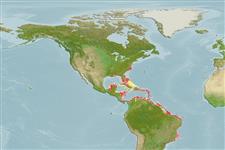Environment: milieu / climate zone / depth range / distribution range
Ecology
Marine; brackish; demersal; depth range 1 - 10 m (Ref. 55208), usually 1 - ? m (Ref. 55208). Subtropical; 45°N - 28°S, 95°W - 33°W (Ref. 55208)
Western Atlantic: New Jersey (rarely in Massachusetts), USA and northern Gulf of Mexico to Argentina; widespread in the West Indies. Throughout Antilles (Ref. 26938).
Length at first maturity / Size / Weight / Age
Maturity: Lm 55.0, range 50 - 60 cm
Max length : 104 cm WD male/unsexed; (Ref. 49746)
Moderate size, with a short blunt snout. Disk has rounded corners, few tubercles and spines along midline (Ref. 26938). Well developed fold on the upper surface and lower surface of tail. Yellowish or light brown above. Lower surface whitish or pure white (Ref. 6902).
Inhabits coastal waters (Ref. 7251). Generally found near shore, to depths of 10 m. Both adults and juveniles frequent estuaries and surf zones (Ref. 27549). Bottom feeder with fish, clams, worms and shrimps. It causes a number of injuries to bathers and waders (Ref. 26938). Ovoviviparous (Ref. 50449). Litters of 2-4 pups; gestation 10-11 months, including a period of embryonic diapause (Ref. 114953).
Life cycle and mating behavior
Maturities | Reproduction | Spawnings | Egg(s) | Fecundities | Larvae
Exhibit ovoviparity (aplacental viviparity), with embryos feeding initially on yolk, then receiving additional nourishment from the mother by indirect absorption of uterine fluid enriched with mucus, fat or protein through specialised structures (Ref. 50449). Distinct pairing with embrace (Ref. 205).
Compagno, L.J.V., 1999. Checklist of living elasmobranchs. p. 471-498. In W.C. Hamlett (ed.) Sharks, skates, and rays: the biology of elasmobranch fishes. Johns Hopkins University Press, Maryland. (Ref. 35766)
IUCN Red List Status (Ref. 130435)
Threat to humans
Traumatogenic (Ref. 4716)
Human uses
Tools
Special reports
Download XML
Internet sources
Estimates based on models
Preferred temperature (Ref.
123201): 23.1 - 28.1, mean 27.1 °C (based on 760 cells).
Phylogenetic diversity index (Ref.
82804): PD
50 = 0.5039 [Uniqueness, from 0.5 = low to 2.0 = high].
Bayesian length-weight: a=0.00646 (0.00265 - 0.01571), b=3.06 (2.86 - 3.26), in cm total length, based on LWR estimates for this (Sub)family-body shape (Ref.
93245).
Trophic level (Ref.
69278): 3.7 ±0.2 se; based on diet studies.
Resilience (Ref.
120179): Low, minimum population doubling time 4.5 - 14 years (Assuming fecundity<100).
Fishing Vulnerability (Ref.
59153): Very high vulnerability (90 of 100).
Nutrients (Ref.
124155): Calcium = 26.4 [3.6, 122.6] mg/100g; Iron = 0.744 [0.197, 2.068] mg/100g; Protein = 23.9 [21.1, 26.5] %; Omega3 = 0.23 [0.06, 0.69] g/100g; Selenium = 12.5 [3.8, 37.8] μg/100g; VitaminA = 9.03 [3.46, 23.49] μg/100g; Zinc = 0.738 [0.357, 1.351] mg/100g (wet weight);
